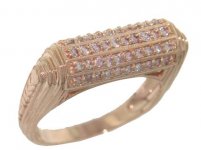jshepherd said:
The pinks on that Site are all pale pinks. In a value comparison it is like a thin-skin blemished Akoya compared to a Hanadama certified strand. Here is a decent list, and I have seen others that quote quite a bit higher as well:
http://www.color-diamond-encyclopedia.com/?st=new&f=ct_EN_3_3.html
If I may chime in, natural pinks are usually light pink because the pink coloration is mostly due to deformities in the crystal formation of the diamond, unlike blues which are due to traces of boron, yellows due to nitrogen atoms, and greens due to irradiation.
Black diamonds are due to inclusions and are very cheap. They usually come in big sizes of a carat or more.
Fancy colored diamonds tend to be lighter in smaller sizes thus most seem lighter in melees. A diamond of the same color saturation e.g. light pink would look "pinker" in bigger, say .5 to 1ct. sizes. I wouldn't be surprised if the Bennifer ring would turn light pink when converted to melees. Same goes for "white diamonds". The brown and yellow colors will be more visible in bigger stones but would look "whiter" in melees.
Although most fancy colored diamonds are enhanced by HPHT treatment, not all will produce the same color. If treatment is by irradiation, then the length of treatment time may determine or add saturation to the color. As far as I know, Type IIa diamonds are best candidates for HPHT treatment. If let's say natural cape (brown) diamonds are about USD1000/ct., then the enhanced canaries which are usually heated capes will cost more because of the enhancement procedures.
When heating capes, the color outcome may turn into canaries or whiter diamonds. It's much like heating natural corundum, you cannot know what the color will be after heating.
Fancy colored diamond melees, like pearls, requires matching. So nice, same colored melees in a ring is not that bad. The pinks are especially harder to match than the canaries, the lemons, the capes, and the greens.

